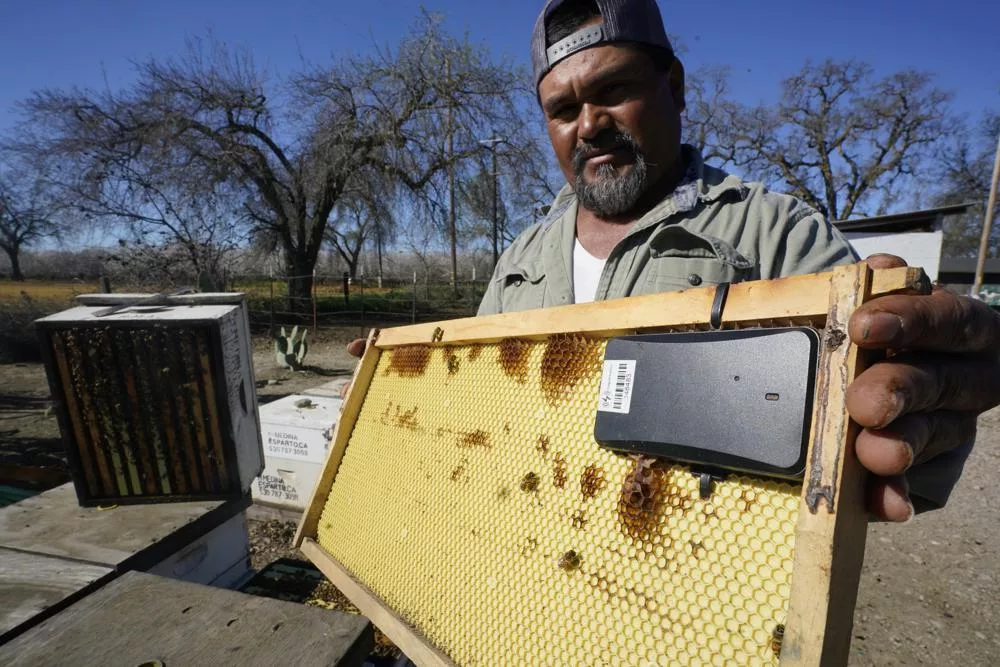For a few frenzied weeks, U.S. beekeepers truck billions of honeybees to California to rent them to almond growers who need to pollinate the state’s most valuable crop.
But as almond trees start to bloom, so begins beehive thefts — an issue so prevalent that beekeepers are now turning to GPS tracking devices, surveillance cameras and other anti-theft technology to protect their colonies.
In the past few weeks, authorities say 1,036 beehives worth hundreds of thousands of dollars were reported stolen from California orchards. The largest heist involved 384 beehives that were taken from a Mendocino County field, prompting the state beekeeper association to offer a $10,000 reward for information leading to their recovery.
Investigators also found honeycomb frames belonging to Helio Medina, another beekeeper who lost 282 hives a year ago.
Medina said the theft devastated his apiary, so this year he placed GPS trackers inside the boxes. He also strapped cable locks around them and installed cameras nearby. As the almond bloom approached and the hives became most valuable, he drove around patrolling the orchards in the dark.
“More often than not, they steal to make money and leave the bees to die,” Rowdy Jay Freeman told AP reporter Daisy Nguyen. Freeman is a Butte County sheriff’s detective who has been keeping track of hive thefts since 2013.
A tightening supply of bees and soaring pollination fees are likely motivating beekeepers to go rogue. It cost under $50 to rent a hive 20 years ago, compared to as much as $230 per hive in 2022.
The demand for bees has steadily risen over the last 20 years as the popularity of almonds as a healthy, crunchy nut turned California into the world’s biggest almond producer. Accordingly, the amount of land used to grow almonds has more than doubled to an estimated 1.3 million acres.
This year, a survey of commercial beekeepers estimated it will take 90% of honeybee colonies in the U.S. to pollinate all the almond orchards.
“What that means is that beekeepers are coming from as far as New York and Florida, and to get them to come all that way, pollinator fees have to rise,” says Brittney Goodrich, an agriculture economist at the University of California at Davis.
Denise Qualls, a pollination broker who connects beekeepers with growers, suspects the thefts are happening because beekeepers can’t provide the strong colonies they promised, “so they can get the money from the grower and then they leave the hives.”
“The grower is just as responsible when they accept them,” she says.
To help her clients track their investments, Qualls merged her business with tech startup Bee Hero to equip hive boxes with a GPS-enabled sensor.
Freeman, who got into beekeeping after investigating his first hive theft, said he advises beekeepers to use security cameras and put their names and phone numbers on the boxes.
He said some beekeepers have tried tagging their boxes with SmartWater CSI, a forensic tool used to help police trace recovered stolen property. The clear liquid is visible only under UV light, even through layers of paint, so police can ascertain the rightful owner even when thieves try to disguise boxes.
To raise the crime’s severity, Freeman worked with prosecutors in 2016 to charge a man accused of stealing 64 beehives with theft of livestock. Under California law, theft of property worth $950 or less is classified as a misdemeanor. But the theft of any agricultural product worth at least $250 is considered a felony. The man pleaded guilty and was sentenced to 90 days in jail and three years probation.
The California State Beekeepers’ Association urges beekeepers to communicate regularly with growers about where their hives are placed and encourages growers to hire reputable beekeepers who can show proof of ownership of their hives. The almond industry, meanwhile, is trying to reduce its dependence on bees by growing “self fertile” almond varieties that require fewer bees for pollination and by investing in research and other initiatives aimed at improving their health.
The Almond Board of California also joined a coalition of agricultural, environmental and government groups to create habitat for wild bees, butterflies and other pollinators on privately owned working lands such as cattle ranches and orchards. The state government is funding $15 million toward the effort, calling it an investment in “climate smart agriculture.”



![[Technology Corner] A Big Step Forward for Interoperability & Data Sharing](https://www.precisionfarmingdealer.com/ext/resources/2025/12/12/A-Big-Step-Forward-for-Interoperability--Data-Sharing.webp?height=290&t=1765565632&width=400)


